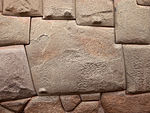Chickee


ChikeeorChickee( "house" in theCreekandMikasuki languagesspoken by theSeminolesandMiccosukees) is asheltersupported by posts, with a raised floor, a thatched roof and open sides. Chickees are also known as chickee huts, stilt houses, or platform dwellings. The chickee style of architecture—palmettothatchover abald cypresslog frame—was adopted by Seminoles during theSecond(1835–42) andThird (1855-58)Seminole Wars as U.S. troops pushed them deeper into theEvergladesand surrounding territory. Before the Second Seminole War, the Seminoles had lived in log cabins.[1]Similar structures were used by the tribes in south Florida when the Spanish first arrived in the 16th century.[2]Each chickee had its own purpose and together they were organized within a camp-type community. Chickees were used for cooking, sleeping, and eating.
Modern use[edit]
Chickees continue to be used by Native American villages of theMiccosukeein the Everglades.[3]Some upscale homes in southern Florida feature chickee-inspired buildings as garden or poolside structures. A few restaurants in Florida still use this indigenous design to attract visitors.

Chickees are also used in backcountry areas ofEverglades National Parkincluding along theEverglades Wilderness Waterwaywhere mangroves or wetlands prevent camping on dry land. Made and maintained primarily for backcountry campers, these wooden structures stand several feet above the water and can usually accommodate four to five campers. These structures have portable restrooms. Some "double chickees" are linked by a walkway and can accommodate eight to ten people. There are about eight to ten chickees in one village. Chickees are very helpful, especially in the rain. Similar structures, while not referred to as chickees, are present further north, in theOkefenokee National Wildlife Refugein southern Georgia.

See also[edit]
- Palapa– a structure with thatched roof and open sides in Mexico
Notes[edit]
- ^Seminole Tribe of Florida - ChickeeArchived2012-02-04 at theWayback Machine,accessed August 14, 2009
- ^Austin, Daniel W. (1997). "The Glades Indians and the Plants they Used. Ethnobotany of an Extinct Culture."The Palmetto,17(2):7 -11.[1]Archived2006-05-25 at theWayback Machine,accessed August 30, 2012
- ^Lundin, Leigh (August 2006)."Swamped".Ellery Queen's Mystery Magazine(8). New York. Archived fromthe originalon 2010-11-20.Retrieved2010-02-02.


